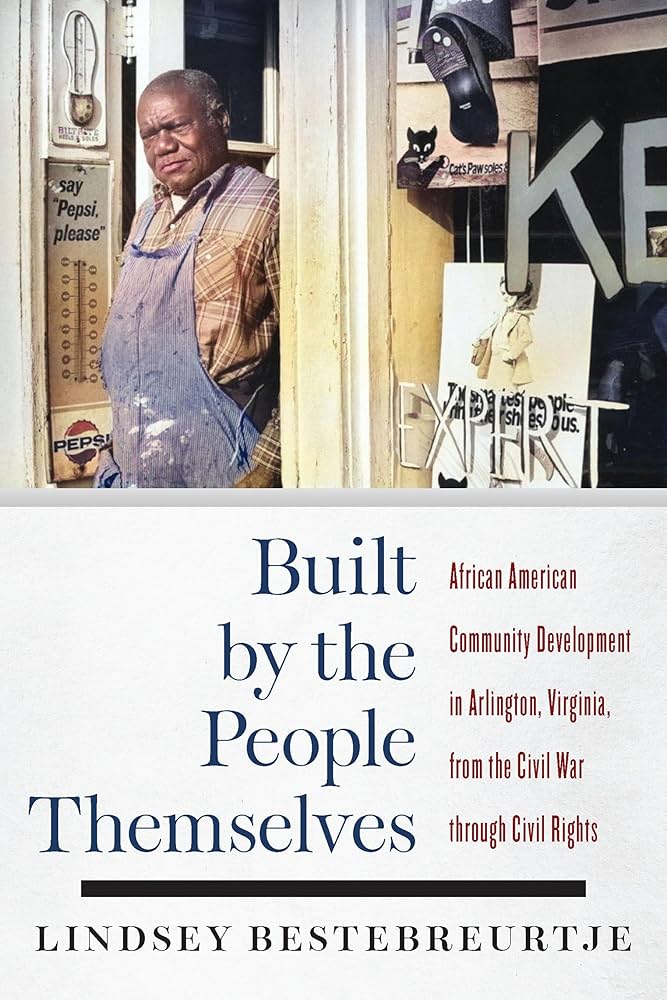

Lindsey Bestebreurtje is a Curatorial Assistant with the Smithsonian’s National Museum of African American History and Culture. This interview is based on her new book, Built by the People Themselves: African American Community Development in Arlington, Virginia, from the Civil War through Civil Rights (University of South Carolina Press, 2024).
JF: What led you to write Built by the People Themselves?
LB: When I moved to Arlington, Virginia in the fall of 2009 to pursue my graduate degree in History, I did not anticipate that my new home would become the topic of my research. A native of Virginia, I grew up in neighboring Fairfax County. The idea that the suburban environs around me held enough history, enough meaning and insight to provide for a historical deep dive had yet to occur to me. Like so many, I wrongly assumed that suburban history began in the 1950s. I thought little of the race, class, legal, and environmental dynamics at play in these homogenous residential spaces of the American suburb that so many call home. I chose to live in the charming condos of the Shirlington neighborhood in southern Arlington. At the time, this area was far less expensive than the more bustling, semi-urban Ballston or Clarendon neighborhoods. One day while out on a walk I saw a wayside along the Washington & Old Dominion trail reading “Nauck: A Neighborhood History.” The sign told of Free Blacks Levi and Sarah Jones who purchased land and built a home in 1844, beginning what would become the African American suburban community of Nauck. I had no idea that Arlington’s suburban roots stretched so far back. But, more significantly, I had no idea that African American home ownership and communities were even a possibility in the Antebellum South. My mind raced with questions. How did this community come to be? How did it survive the Civil War, Jim Crow, suburbanization, and gentrification through to today? These questions merged with my academic interests in suburbanization, residential segregation, and the role of the built environment in people’s lives. Like many first books, Built By the People Themselves started as my doctoral dissertation.
JF: In 2 sentences, what is the argument of Built by the People Themselves?
LB: Built By the People Themselves tracks African American community development as the processes of suburbanization and segregation shaped lives, the built environment, and the law in the northern Virginia county of Arlington from the 1860s to the 1970s. A hostile white environment alongside an active African American community in Arlington shows the strategies Black Arlingtonians used to create lasting communities that met their own needs and reflected their own preferences to the greatest extent possible within the context of white domination in a Jim Crow society.
JF: Why do we need to read Built by the People Themselves?
LB: Academic and general audiences should read Built by the People Themselves to expand their understanding of the African American experience. This previously unknown local suburban history reveals how African Americans carved out spaces for themselves and created the kinds of neighborhoods and communities they thought ideal within the confines of the Jim Crow South.
I believe that historians are public servants responsible with the task of preserving the past and telling complicated stories for a public who may be bettered by hearing them. In this way, I hope that my research may be used as a guide post to assist Black Americans in finding their own long roots in America’s suburban landscape. I hope that this book will spark future conversations and learning opportunities.
JF: Why and when did you become an American historian?
LB: My Dad, Anton, was always passionate about history. He always used to take me antiquing. And growing up just outside of Washington, D.C. there were so many amazing museums and National Parks to visit.
All of this helped to spark my interest, but I truly became passionate about American history when I was about 8 years old. I read a historical fiction novel about a young woman from the Gilded Age. An orphan raised outside of New York City by her wealthy extended family, she became a supporter of labor rights after learning about the working conditions for children her own age. This novel became my entry point to the power of history, and how important it is to see yourself in historical narratives. Though fictional, the main character was the gateway that led to my passion for American history. I went on to major in History at the College of William and Mary, earn a Master’s in Museum Studies, and a Ph.D. in American History before working as a historian at the National Park Service, the Historic American Building Survey, the Roy Rosenzweig Center for History and New Media, George Mason University Archives, and the Smithsonian. All of this was because of a character named Samantha Parkington – my first American Girl doll.
JF: What is your next project?
LB: I work as a Public Historian in the Curatorial department at the Smithsonian’s National Museum of African American History and Culture. I am currently working on an exhibition about the Black presence in the White House. It explores the White House as a place of work, a hub of political power, a residence, and a building in the majority Black city of D.C. all through the lens of the African American experience from the 1790s to today. The exhibition is set to open in 2026 in time to celebrate the 250th anniversary of our nation’s founding.
JF: Thanks, Lindsey!